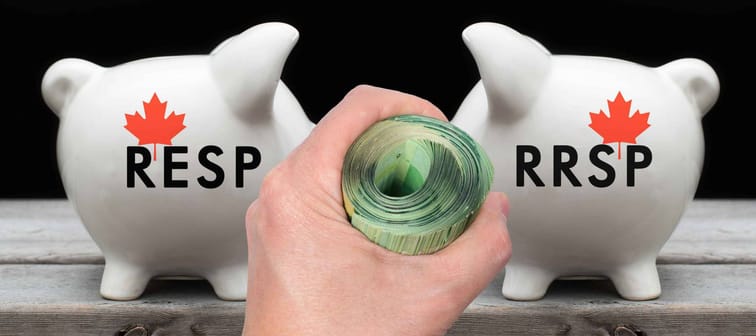How to decide between the RESP vs RRSP
Choosing between the RESP and the RRSP will depend a lot on your personal circumstances and financial goals for your family. Because these are primarily investment vehicles to minimize income taxes, your household income and marginal tax rate have the greatest implication on which account is best for your money. However, your timeline, lifestyle, and values will also influence your decision.
Nevertheless, both the RRSP and the RESP contribute to your family’s long-term financial security so they should not be considered completely independent, particularly when there are ways to use the powers of one to benefit the other!
How RESP works in Canada
The Registered Education Savings Plan (RESP) is a tax-sheltered and government-supported account to help Canadians save for their children’s post-secondary educations. Like the RRSP, this is an investment account where you can hold cash, GICs, mutual funds, stocks, bonds, or ETFs. To really take advantage of the power of the RESP, your best bet is to choose a more aggressive investment option and open an investing account.
These investments will grow tax-deferred until the money is withdrawn from the RESP. Because students typically have no or very little taxable income, it is often more favourable for them to claim the withdrawal from the RESP to minimize income taxes paid.
To further encourage you to save, the Government of Canada will match 20% of your contributions to a maximum of $500 per year and a lifetime maximum of $7,200 through the Canada Education Savings Grant (CESG). This is free money that can be invested with the rest of your RESP contributions to grow through interest, dividends, and capital gains until your child makes a withdrawal for their post-secondary education.
For example, if you contribute $2,500 a year to an RESP, the CESG will be deposited directly to the account for a total of $3,000. You can then invest that full sum and all the interest, dividends, and capital gains will remain tax-sheltered until the time of withdrawal.
RESPs are a great way to give your child an awesome financial head start. Paying for your child’s post-secondary education with RESPs help reduce or even eliminate the need for them to take out student loans. This will allow them to graduate debt-free and begin saving and investing earlier in their own life to enjoy long-term financial security.
READ MORE: A Guide to RESPs in Canada
How does an RRSP work?
The Registered Retirement Savings Plan (RRSP) is a tax-sheltered account to help Canadians save for retirement. Despite the word “savings” in its name, this is an investment account where you can hold cash, GICs, mutual funds, stocks, bonds, or ETFs. If you’re a savvy investor, you can DIY with a reputable online brokerage or have your money managed through a robo-advisor.
Another option is to open an RRSP savings account with a reputable bank offering high-interest rates.
You do not pay taxes on the income you contribute towards your RRSP at the time you make your contribution. You will pay taxes when you make withdrawals from your RRSP at retirement. This lets the money in your RRSP grow tax-deferred until you make a withdrawal. Because many people will have a lower income in retirement than they do during their working lifetime, the RRSP is a great way to reduce your lifetime income tax burden.
READ MORE: A guide to RRSPs in Canada
Case Study: Mike and Mindy
Let’s break it down with Mike and Mindy as an example.
Mike and Mindy are 40 years old and have a five-year-old child. They want to help pay for their child’s post-secondary education, so they open an RESP. They also hope to retire or at least reduce their full-time workload at 55 years old, so they also open RRSPs. Mike and Mindy are both professionals and each makes $70,000 to $80,000 a year.
For the sake of our comparison, let’s use a return of 7% for both of the accounts.
Mike and Mindy could contribute $2,500 to an RRSP. Their marginal tax rate is 39.4%, so they receive a tax refund of $984 for their contribution. Mike and Mindy are dependable savers and add the tax refund to their RRSP for a total investment of $3,484. In 15 years at 7% returns, their investment has compounded to $9,612.47.
On the other hand, they could contribute that $2,500 to an RESP. The Government of Canada would match 20% of their contribution as part of the CESG, kicking in $500 and bringing their total investment to $3,000. After 15 years at a 7% return, they have $8,277.09 in the account.
At this point, it looks like the initial advantage of that tax deduction beat the CESG contribution, but we have neglected to measure the tax impact upon withdrawal. Their child will be allowed to earn approximately $22,000 or so before she has to pay any taxes. So if she is not working part-time when attending school and withdraws only from her RESP, the money will be essentially tax-free. Mike and Mindy knew they wanted a fair degree of security in their retirement, so they have a decent income and a marginal tax rate of 27.75%. This means that their after-tax return on their original investment will be $6,945.01 when withdrawn from the RRSP. That’s almost $1,400 less than the RESP.
Any money saved is excellent, but this does illustrate how important tax considerations are in financial planning.
When to prioritize the RRSP before the RESP
One of the most important things to realize is that your child will be able to take out student loans for their post-secondary education, but you will not be able to take out loans for your retirement. Remembering this should help you prioritize your own retirement before the college savings for your children. You may also want to consider whether a TFSA or RRSP works better for you.
If you have no retirement savings established for yourself or provided by your employer, it is imperative that you begin saving immediately. Because RRSPs can reduce your income tax burden, they are especially powerful for high-income individuals who have high tax rates. You can begin making RRSP contributions now, then claim your contributions when you file your income taxes to get an income tax refund. At that time, you could use your income tax refund to make a deposit into your child’s RESP, instead of topping up your RRSP.
READ MORE: TFSA vs. RRSP
When to prioritize the RESP before the RRSP
If you already have some retirement savings set aside for yourself and it’s personally important for you to contribute to your child’s post-secondary, it might be right for you to choose the RESP over the RRSP. You may choose to make enough contributions to the RESP to qualify for the maximum CESG match by the Government of Canada. Once you receive the annual and lifetime maximum CESG, you might then choose to focus your efforts on topping up your RRSP.
It’s also very important to note that any RESP contributions to a maximum of $50,000 that your child does not use for their post-secondary education can be transferred to your RRSP completely tax-free. In this context, contributions made to the RESP might actually end up as contributions made to your RRSP! However, it is difficult to know how expensive your child’s post-secondary education will be, particularly if they choose to pursue more than one degree, so gambling that there will be an excess in their RESP leftover for you definitely has some risk.
The other factor that may dictate whether to choose the RESP vs RRSP is your timeline for each. Maybe you’re in a less common situation where your retirement is actually closer than your child’s post-secondary matriculation, in which case you might want to focus on topping up your RRSP before you add funds to their RESP.
On the other hand, maybe you weren’t able to save for the first few years of your child’s life, and now you want to get as much of the CESG as you can before they finish school so you choose to contribute to their RESP instead of your RRSP. More likely than not, you have decades to save for both your retirement and your child’s post-secondary education, and it’s okay to have some years focused on one goal and then other years where you plod away at the other.
Don’t forget there are other ways to help your child as a post-secondary student than only paying their tuition bill. Maybe you cannot afford to contribute a lot of money to an RESP, but you will be able to let your child live at home rent-free while they study. Knowing you can offer this non-financial contribution to their post-secondary education should help you make the decision to focus on the RRSP if that’s what’s best for you.
RRSPs are a powerful tool to secure long-term financial security for yourself. Perhaps you’re less keen to pay for your child’s post-secondary education, but do plan to leave them an inheritance, and an RRSP is likely part of this plan. Ultimately, both the RESP and RRSP are designed to serve your family’s financial security, and contributing to either will benefit you immensely!
The bottom line
Whether you’re focusing on the RRSP, the RESP, or contributing to both, make sure you choose to invest in these accounts and automate the process. Where stashing your money in a savings account might only earn you 1% or 2% in interest, you can potentially earn much greater returns by investing in the stock market. Because both RRSP and the RESP typically have very long time horizons, investing is the best way to maximize the powers of these accounts!
If you’re a DIY investor, I recommend using a pre-authorized contribution plan to your discount brokerage account so you invest consistently.
If you don’t feel confident managing your own investment portfolio, there are a number of excellent robo-advisors in Canada that will invest on your behalf. All you need to do is open an RRSP or RESP (or both!) and set up automatic contributions, and they’ll take care of the rest. For the RESP, your CESG disbursements will be automatically deposited to the account and invested on your behalf.
Lastly, if you’re looking to supercharge your savings, consider opening an RRSP savings or GIC account with a bank offering high-interest rates.
READ MORE: What are RRSPs, TFSAs, and RESPs anyway?






